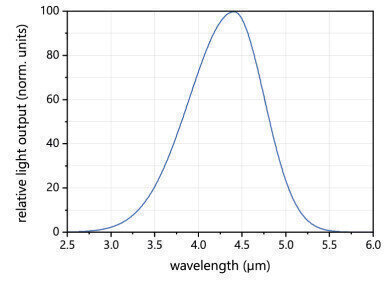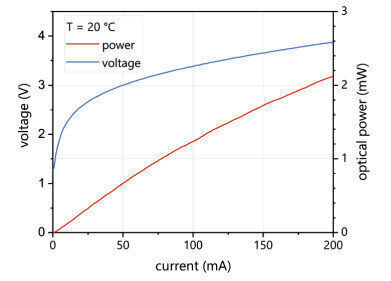-
 Figure 1: Spectrum of a nanoplus 4.3 µm Mid-Infrared LED
Figure 1: Spectrum of a nanoplus 4.3 µm Mid-Infrared LED -
 Figure 2: Power, voltage and current characteristics of a nanoplus 4.3 µm Mid-Infrared LED
Figure 2: Power, voltage and current characteristics of a nanoplus 4.3 µm Mid-Infrared LED
Gas Detection
NEW Mid-infrared light-emitting diodes (MIR LED) from 2800 nm to 6500 nm for gas sensing
Mar 09 2021
nanoplus presents continuous-wave Mid-Infrared LEDs (MIR LED) at any customised wavelength between 2800 nm and 6500 nm. The devices feature continuous-wave operation at room temperature, little power consumption, and a relatively small spectral bandwidth. With these specifications, they are a broadband, incoherent and cost-effective alternative to lasers for many gas sensing applications. Portable detectors especially will benefit from their high wall-plug efficiencies. The mid-infrared LEDs are available on ceramic sub-mount or printed circuit board (PCB).
Read more about the MIR LED specifications.
The wavelength window between 3 μm and 6 μm is a key for high-precision gas analysis based on tunable diode laser absorption spectroscopy (TDLAS). Many trace gases ubiquitous to industrial sites have their strongest absorption bands in this region. They show absorption strengths that are several orders of magnitude higher than those in other infrared areas. This concerns prevalent molecules such as carbon dioxide (CO2), nitric oxide (NO), or water (H2O). Most hydrocarbons, such as methane, ethane, or acetylene, equally locate their topmost absorbing features at these mid-infrared wavelengths.
Trace gas analysers that take advantage of the molecules’ strongest absorption bands benefit from a higher detection accuracy, accelerated sensing speed, less noise, and, last but not least, a smaller footprint.As a laser expert for TDLAS-based gas sensing, nanoplus offers a variety of light sources to industry and research.
The nanoplus flagship product is Distributed Feedback Interband Cascade Lasers (DFB ICL). They are available at any target wavelength between 2800 nm and 6500 nm and have an extremely narrow linewidth of typically < 0.1 nm. At top-rated wavelengths, they show output powers up to 10 mW.
Very recently nanoplus introduced high-power Fabry-Pérot lasers in the mid-infrared. The multimode devices reach up to 1 W at wavelengths between 1950 nm and 2350 nm. They are packaged on a submount with an AlN carrier. Possible applications include the medical sector, pumping of solid-state lasers, or materials processing.
Finally, Superluminescent Diodes (SLD) complete nanoplus portfolio of light sources in the mid-infrared. Designed at any customized wavelength from 760 nm to 2900 nm these broadband devices combine the proven beam quality of nanoplus DFB lasers with the large spectrum of LEDs.
nanoplus is a fully vertically integrated company. They control the entire process chain from design to the packaging at their two ISO 9001:14001 certified production sites in Germany. This enables them to provide customised solutions for any client. Do not change your ideas, let them deliver a light source that fits your application.
Digital Edition
AET 28.3 September 2024
September 2024
Business News - ENVEA announces acquisition of APAQ Group - SICK and Endress+Hauser sign strategic partnership - Efforts to curb gas flaring intensify amid environmental concerns Air Monito...
View all digital editions
Events
WEATHER • CLIMATE • WATER / EARTH OBSERVATIONS / GREEN ECONOMY
Oct 29 2024 St. Petersburg, Russia
Oct 30 2024 Hong Kong
Nov 05 2024 Toronto, Canada
Nov 05 2024 Rimini, Italy
Nov 06 2024 Ho Chi Minh City, Vietnam


















